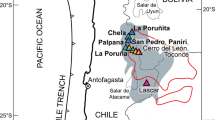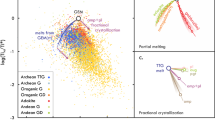Abstract
Massif-type anorthosites are large igneous complexes of Proterozoic age. They are almost monomineralic, representing vast accumulations of plagioclase with subordinate pyroxene or olivine and Fe–Ti oxides—the 930-Myr-old Rogaland anorthosite province in southwest Norway1 represents one of the youngest known expressions of such magmatism. The source of the magma and geodynamic setting of massif-type anorthosites remain long-standing controversies in Precambrian geology, with no consensus existing as to the nature of the parental magmas or whether these magmas primarily originate in the Earth's mantle or crust. At present, massif-type anorthosites are believed to have crystallized from either crustally contaminated mantle-derived melts that have fractionated olivine and pyroxenes at depth2 or primary aluminous gabbroic to jotunitic melts derived from the lower continental crust3. Here we report rhenium and osmium isotopic data from the Rogaland anorthosite province that strongly support a lower crustal source for the parental magmas. There is no evidence of significantly older crust in southwest Scandinavia and models invoking crustal contamination of mantle-derived magmas fail to account for the isotopic data from the Rogaland province. Initial osmium and neodymium isotopic values testify to the melting of mafic source rocks in the lower crust with an age of 1,400–1,550 Myr.
This is a preview of subscription content, access via your institution
Access options
Subscribe to this journal
Receive 51 print issues and online access
$199.00 per year
only $3.90 per issue
Buy this article
- Purchase on Springer Link
- Instant access to full article PDF
Prices may be subject to local taxes which are calculated during checkout



Similar content being viewed by others
References
Schärer, U., Wilmart, E. & Duchesne, J. C. The short duration and anorogenic character of anorthosite magmatism: U-Pb dating of the Rogaland complex, Norway. Earth Planet. Sci. Lett. 139, 335–350 (1996).
Emslie, R. F. in The Deep Proterozoic Crust in the North Atlantic Provinces (eds Tobi, A. C. & Touret, J. L. R.) 39–60 (Reidel, Dordrecht, 1985).
Longhi, J., Vander Auwera, J., Fram, M. S. & Duchesne, J. C. Some phase equilibrium constraints on the origin of Proterozoic (massif) anorthosites and related rocks. J. Petrol. 40, 339– 362 (1999).
Scoates, J. S. & Frost, C. D. A strontium and neodymium isotopic investigation of the Laramie anorthosites, Wyoming, USA: Implications for magma chamber processes and the evolution of magma conduits in Proterozoic anorthosites. Geochim. Cosmochim. Acta 60, 95–107 (1996).
Longhi, J., Fram, M. S., Vander Auwera, J. & Montieth, J. N. Pressure effects, kinetics, and rheology of anorthositic and related magmas. Am. Mineral. 78, 1016– 1030 (1993).
Mitchell, J. M., Scoates, J. S. & Frost, C. D. High-Al gabbros in the Laramie Anorthosite Complex, Wyoming: implications for the composition of melts parental to Proterozoic anorthosite. Contrib. Mineral. Petrol. 119, 166–180 (1995).
Demaiffe, D. & Hertogen, J. Rare earth element geochemistry and strontium isotopic composition of a massif-type anorthositic-charnockitic body: the Hidra Massif (Rogaland, SW Norway). Geochim. Cosmochim. Acta 45, 1545–1561 ( 1981).
Robins, B., Tumyr, O., Tysseland, M. & Garmann, L. B. The Bjerkreim–Sokndal Layered Intrusion, Rogaland, SW Norway: Evidence from marginal rocks for a jotunite parent magma. Lithos 39, 121– 133 (1997).
Duchesne, J. C. & Hertogen, J. Le magma parental du lopolithe de Bjerkreim–Sokndal (Norvège méridionale). C. R. Acad. Sci. 306, 45– 48 (1988).
Morse, S. A. A partisan review of Proterozoic anorthosites. Am. Min. 67, 1087–1100 (1982).
Menuge, J. F. The petrogenesis of massif anorthosites: a Nd and Sr isotopic investigation of the Proterozoic of Rogaland/Vest-Agder, SW Norway. Contrib. Mineral. Petrol. 98, 363–373 (1988).
Ashwal, L. D. & Seifert, K. E. Rare-earth-element geochemistry of anorthosite and related rocks from the Adirondacks, New York, and other massif-type complexes: Summary. Geol. Soc. Am. Bull. 91, 105–107 (1980).
Simmons, E. C. & Hanson, G. N. Geochemistry and origin of massif-type anorthosites. Contrib. Mineral. Petrol. 66, 119–135 ( 1978).
Taylor, S. R., Campbell, I. H., McCulloch, M. T. & McLennan, S. M. A lower crustal origin for massif-type anorthosites. Nature 311, 372–374 (1984).
Stein, H. J., Morgan, J. W., Markey, R. J. & Wiszniewska, J. A Re-Os study of the Suwalki Anorthosite Massif, Northeast Poland. Geophys. J. 4, 111–114 ( 1998).
Demaiffe, D., Weis, D., Michot, J. & Duchesne, J. C. Isotopic constraints on the genesis of the Rogaland anorthositic suite (Southwest Norway). Chem. Geol. 57, 167–179 (1986).
Emslie, R. F., Hamilton, M. A. & Thériault, R. J. Petrogenesis of a Mid-Proterozoic anorthosite-mangerite-chanockite-granite (AMCG) complex: Isotopic and chemical evidence from the Nain Plutonic Suite. J. Geol. 102, 539–558 (1994).
Walker, R. J., Carlson, R. W., Shirey, S. B. & Boyd, F. R. Os, Sr, Nd and Pb isotope systematics of southern African peridotite xenoliths: Implications for the chemical evolution of subcontinental lithospheric mantle. Geochim. Cosmochim. Acta 53, 1583– 1595 (1989).
Asmerom, Y. & Walker, R. J. Pb and Os isotopic constraints on the composition and rheology of the lower crust. Geology 26, 359–362 (1998).
Esser, B. K. & Turekian, K. K. The osmium isotopic composition of the continental crust. Geochim. Cosmochim. Acta 57, 3093–3104.
Johnson, C. M., Shirey, S. B. & Barovich, K. M. New approaches to crustal evolution studies and the origin of granitic rocks: what can the Lu-Hf and Re-Os isotope systems tell us? Trans. R. Soc. Edinb. 87, 339– 352.
Esperança, S., Carlson, R. W., Shirey, S. B. & Smith, D. Dating crust-mantle separation: Re–Os isotopic study of mafic xenoliths from central Arizona. Geology 25, 651– 654 (1997).
Saal, A. E., Rudnick, R. L., Ravizza, G. E. & Hart, S. R. Re–Os isotopic evidence for the composition, formation and age of the lower continental crust. Nature 393, 58– 61 (1998).
Frick, L. R., Lambert, D. D. & Cartwright, I. Re–Os dating of metamorphism in the Lewisian Complex, NW Scotland. Goldschmidt Symp. (Heidelberg) J. Conf. Abs. 1, 85 (1996).
Versteeve, A. J. Isotope geochronology in the high-grade metamorphic Precambrian of Southwestern Norway. Geol. Surv. Norway Bull. 318, 1– 50 (1975).
Michard, A., Gurriet, P., Soudant, M. & Albarede, F. Nd isotopes in French Phanerozoic shales: external vs. internal aspects of crustal evolution. Geochim. Cosmochim. Acta 49, 601– 610 (1985).
Lambert, D. D., Foster, J. G., Frick, L. R., Ripley, E. M. & Zientek, M. L. Geodynamics of magmatic Cu-Ni-PGE sulfide deposits: New insights from the Re-Os isotope system. Econ. Geol. 93, 121–135 (1998).
Andersson, M., Lie, J. E. & Husebye, E. S. Tectonic setting of post-orogenic granites within SW Fennoscandia based on deep seismic and gravity data. Terra Nova 8, 558–566 ( 1996).
Duchesne, J. C., Liégeois, J. P., Vander Auwera, J. & Longhi, J. The crustal tongue melting model and the origin of massive anorthosites. Terra Nova 11, 100–105 (1999).
Acknowledgements
Financial support for Re–Os isotopic studies at Monash University derive from the Monash University Research Fund, the Australian Crustal Research Centre, and the Australian Research Council. The research reported here was supported by the Norwegian Research Council.
Author information
Authors and Affiliations
Corresponding author
Supplementary Information
Rights and permissions
About this article
Cite this article
Schiellerup, H., Lambert, D., Prestvik, T. et al. Re–Os isotopic evidence for a lower crustal origin of massif-type anorthosites. Nature 405, 781–784 (2000). https://doi.org/10.1038/35015546
Received:
Accepted:
Issue Date:
DOI: https://doi.org/10.1038/35015546
This article is cited by
-
Petrogenesis of massif-type anorthosite complex, Gruber, Central Dronning Maud Land, East Antarctica: Implications for magma source and evolution
Chinese Journal of Geochemistry (2009)
Comments
By submitting a comment you agree to abide by our Terms and Community Guidelines. If you find something abusive or that does not comply with our terms or guidelines please flag it as inappropriate.



